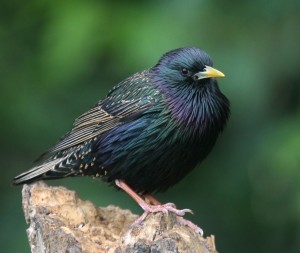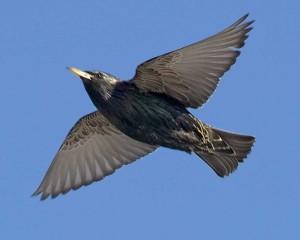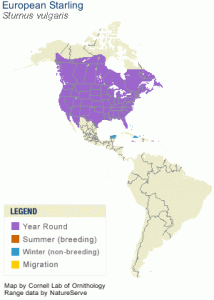The European Starling was first brought to North America from Europe in the 1890’s by Shakespeare enthusiasts. Although not indigenous to the continent, the starling has spread to occupy most of the continent.
The European Starling is a medium sized bird that can be described as “chunky and blackbird- sized”. The breeding adult has a purple and green luminous color pattern, which can be mistaken for black from long distances. Their rather green iridescent plumage, which shows up in the summer, is punctuated by their short tails and long yellow slender beaks. However in the winter, their plumage changes to a fresh brown color covered with white specks. The non-breeding adult has a black beak and light spots, while juveniles are drab gray-brown overall. In flight the wings of the starling are pointed and short allowing to look like a four point star which is said to give them their name (Flux 2013).
Starlings are classified as songbirds and are great vocal mimics. They have been known to imitate the songs of many other birds types and even human speech. This is an extremely interesting topic and will be discussed more in depth in Part 2.
This type of starling can be found mainly in open groves, fields, farm country and in suburbs and cities. Though they are not generally found in large stretches of forest or desert, they need areas which have an open water source and cavities for their nesting purposes.
In terms of gathering food, starlings can be classified as ground foragers indicating that they forage on the ground and places with short vegetation. They force their beaks into the ground to search for insects. The starling will forage for mostly insects, berries, and seeds but their diet is quite varied. An interesting fact about the starling is that they often form flocks and forage with many different types of birds such as House Sparrows and American Robins. Although they forage alongside other birds, European Starlings are very aggressive birds. They are known to chase birds off a nesting site that they have deemed theirs. Often, they resort to even more drastic measures and kill the babies already living in the nests that they wish to occupy. This causes many issues for native species, as their homes and families are often lost.
Males choose nesting sites in late winter and begin building the nests. Popular places for this are cavities in trees or buildings, and often times holes previously used by woodpeckers. The males begin building the nests slowly, and when a female comes along the progress speeds up. Females then select males in the breeding season based on song or nest site. It is not uncommon for migratory females returning to an area to nest in the same spot again, regardless of which male is there, though for each breeding season the pair is usually monogamous (Flux 1995). Males may also fight over a specific breeding site. If this occurs, the birds fight until one gives up or dies. When a male has won a territory and a female comes to mate with him, she initiates copulation. Female starlings “approach their singing mates, and present themselves in a submissive posture with slightly drooping wings, and give a series of “very delicate notes” to indicate readiness” (Cabe 1993).
Starlings are very social, and do many things in groups including feeding, roosting, and migrating. While they may breed away from the group, if nesting sites are available starlings prefer to nest near each other. They go out of their way to kick other species out of their cavities in trees so that they can claim them for their own nesting purposes, and are especially at odds with woodpeckers, who make the most cavities. Most interspecies interactions have to do with feeding and territory defense (Heather and Robertson 1996). If a male starling enters the territory of another, the male who owns the territory will stretch its neck and attempt to appear bigger (called the Stare), which often results in the other bird retreating. If the bird does not retreat, the behavior may escalate to bill fencing, in which the birds take turns trying to stab each other. This continues until one submits.
The European Starling migration depends on the region in which the bird is breeding. Some breeding birds stay put while juveniles migrate, and some birds migrate in one year but not in the next. The European starlings found in dutchess county are among those who migrate yearly. The birds travel along the coast or along rivers such as the Mississippi and the Ohio. Though males and females have roughly the same migratory patterns, birds migrating for the first time may cover greater distances than birds who have been migrating longer. Adult European Starlings migrate to the same areas, while juveniles migrate in a certain direction. As they grow older and have been migrating longer, birds learn landmarks and other features that help them to find their way.
References:
Cabe, Paul R. 1993. European Starling (Sturnus vulgaris), The Birds of North America Online (A. Poole, Ed.).
Flux, J.E.C.; Thompson, C.F. 1995. Distribution of parental effort between nestlings of European starlings: runting and the spoilt-brat strategy. New Zealand Journal of Zoology 22: 331-338.
Flux, J.E.C. 2013. Common starling. In Miskelly, C.M. (ed.) New Zealand Birds Online. www.nzbirdsonline.org.nz
Heather, B.D.; Robertson, H.A. 1996. The field guide to the birds of New Zealand. Viking, Auckland.
NestWatch. (n.d.). Retrieved May 1, 2015, from http://nestwatch.org/learn/all-about-birdhouses/managing-house-sparrows-and-european-starlings/




it’s like an evil bird,maybe because it’s eyes, lol